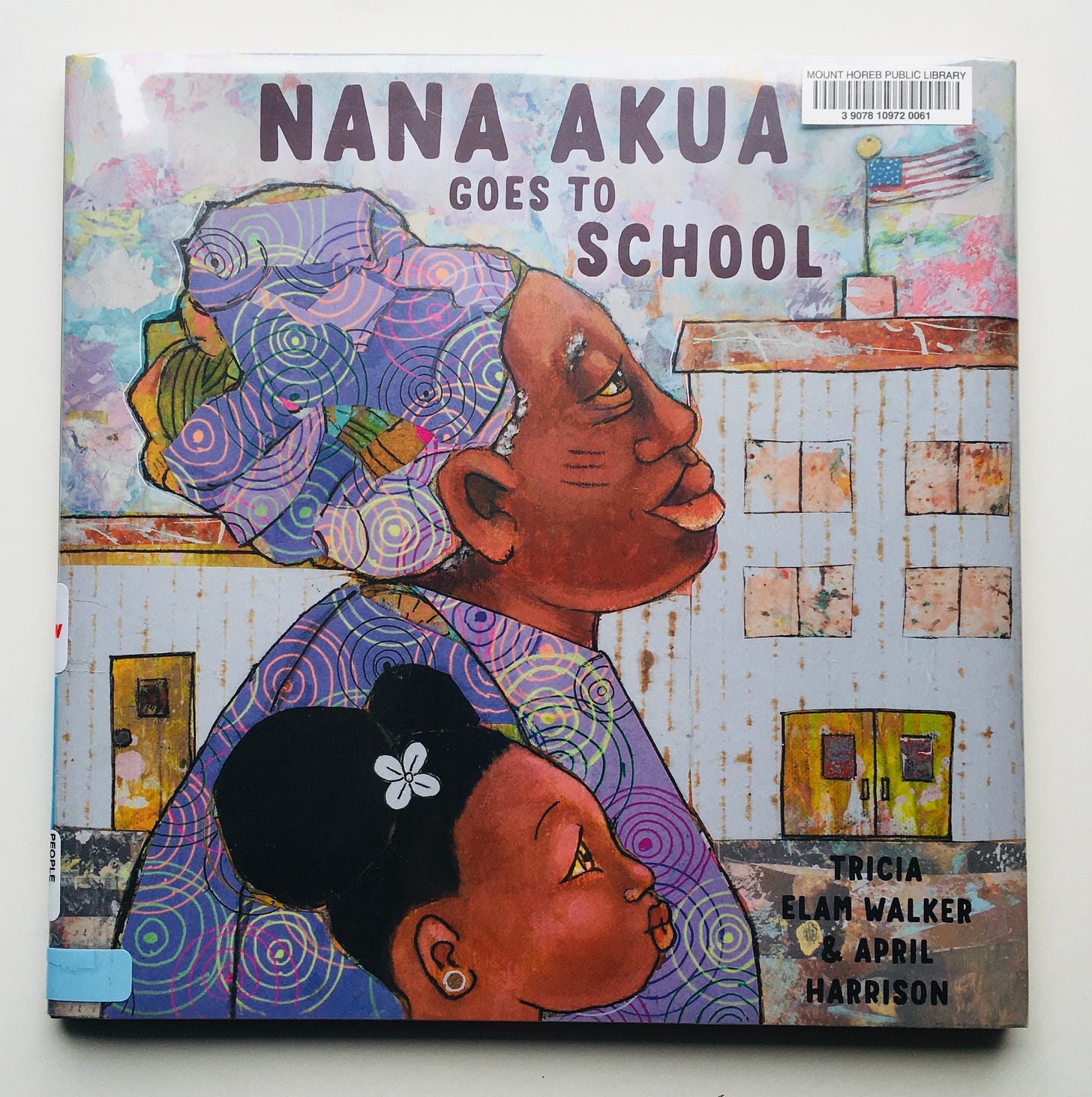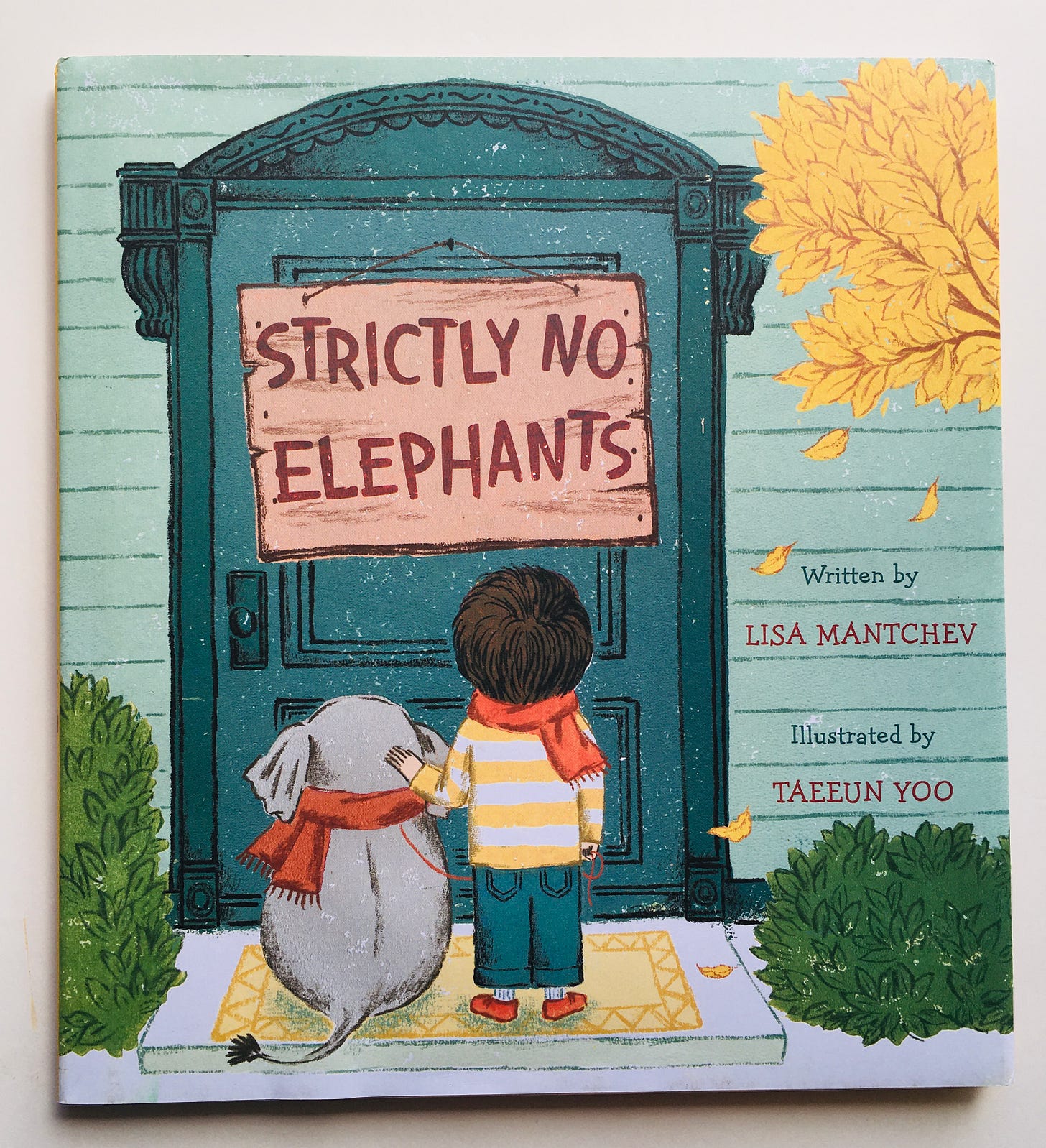Can we read? No. 40
Good morning! Happy Tuesday.
A couple of things before we get started:
ICYMI: I sent my special edition on summer last week. Lots of great stuff there, especially if you’re looking for some fun new titles for the season.
And: recently I asked a tiny group of my most faithful readers for to take a short survey about this newsletter — I learned so much (so much!) and the feedback was so rich that I’ve decided to offer it to everyone. If you have a few minutes, I’d deeply appreciate your thoughts! Click here to tell me what you think.
Onwards!
Nana Akua Goes to School by Tricia Elam Walker, illustrated by April Harrison (2020)
It’s Grandparents Day at school, and Zura wants to bring “her favorite person in the whole universe,” her Nana Akua, but Zura is afraid that her classmates will laugh at the traditional Ghanaian tribal markings on her Nana’s face — a tradition her grandmother is proud of but that Zura has noticed can sometimes attract negative attention in public. “It feels hard to explain, but Zura wants to try” and her grandmother not only responds with loving understanding but a great idea: they will bring the quilt from Zura’s bed, which has a pattern of Adrinka symbols of the Akan people of Ghana, to class to help explain this cultural tradition. This idea works — Nana Akua explains to Zura’s class that the symbols on the quilt as well as her face represent “more than fifty important qualities, like wisdom and creativity,” and then offers to paint the faces of all the children with a symbol of their choice. What could have been a painful experience for both granddaughter and grandmother alike becomes a gentle and fun explanation — and acceptance — of an ancient culture that brings young and old together. In a note about the story, Elam Walker states that she learned about Adrinka symbols from her experience of placing her own children in African-centered schools several decades ago, and the story, which pays homage to several Ashanti traditions, shows both this personal familiarity with the subject as well as the deep respect with which she has approached it. Harrison’s soft illustrations show every emotion the characters feel, and are strangely moving. This is a special one.
Strictly No Elephants by Lisa Mantchev, illustrated by Tae-eun Yoo (2015)
“The trouble with having a tiny elephant for a pet is that you never quite fit in.” Thus begins the tender story of a little boy and his companion elephant, who set off to attend a Pet Club meeting one day only to find a sign on the door that makes it abundantly clear they are not wanted (see cover above). This is disheartening to be sure, but as the boy and the elephant walk away, literally and figuratively, they find someone else in the same predicament: a girl with a skunk who was also rejected from Pet Club Day. Together this motley crew decides to start their own club — suddenly all the somewhat-stranger pets in the neighborhood come out (a boy with an armadillo, another with a narwhal in a bowl, a girl with a bat) — and find the perfect headquarters in a treehouse in the park. The first order of business? Posting their own sign that reads, “ALL ARE WELCOME.”
It’s hard for me to think of a title with more moving messages about friendship, loyalty, inclusion, and courage in the face of rejection — Mantchev’s pitch-perfect prose coupled with Yoo’s linoleum block print, pencil and Photoshopped illustrations make for a compelling, even emotional read. That friends “lift each other over the cracks,” friends “brave the scary things for you,” friends “never leave anyone behind” is something we all benefit from hearing so that when a true friend comes along, we can recognize them at once.
The Way I Feel by Janan Cain (2000)
My 7yo, a sweet-tempered, curious, thoughtful girl, is a poster child of social-emotional learning: years of intentional reading and conversation and flat-out training (not to mention 18 months of occupational and speech therapy that focused heavily on the processing and expression of feelings*) made this so. My 4yo daughter is loyal, brave, deeply loving, and… you know the character Jack-Jack from the Pixar movie, The Incredibles? How sometimes he is a chubby little baby so cute you could just eat him and then other times he turns into a hot pink demon with crazy eyes and also sometimes spontaneously bursts into flames?* That.
Two different kids, two different people. Two different hearts, two different spirits. Two totally different abilities to self-regulate. This book was helpful to both of them. It’s not a narrative — there is no cohesive story, nor even one singular character to follow throughout — but more a page-by-page example of possible human emotions (going beyond the norm of simply “angry” and “sad” to more nuanced feelings, from “silly” to “scared” to “disappointed” to “thankful”). Cain’s rhyming prose, limited to only two sentences per page, flows with ease and is matched perfectly by her vibrant pastel pencil images. This is an excellent book to use to share and discuss different emotions (especially in those toddler and preschool years) not least because it normalizes all of it but because it lacks any kind of judgment whatsoever. We all feel frustrated, shy, bored, excited. We all sometimes even act like Jack-Jack (raising my hand high here ✋ — my kid comes by her fire honestly). The message that this is not only true but entirely okay is an important one, as it tells our children what we all most need to hear: I see you and accept you exactly as you are.
*Only some of you will understand me when I say: this book puts me in the Green Zone.
When Green Becomes Tomatoes: Poems for All Seasons by Julie Fogliano, illustrated by Julie Morstad (2016)
It’s not a secret how much I love poetry and how important I think it is for children — I’ve written in all caps about this more than once, I’ll say it again today, and it won’t be the last time by any means. In fact, I have earmarked a future issue of (How) Can we read? to discuss the importance of poetry, as well as a Spotlight On: Poetry edition, which I’ll probably write in 2022 — the point being, I am playing the long game when it comes to poetry evangelism, which I might as well admit right now.
People — not children, mind you, but their grownups — get hung up on poetry, in a bad way. They don’t understand it — or believe they’re supposed to understand it — and so they dislike it — or think they dislike it. If this is you, Julie Fogliano is an excellent poet-author to explore, as her work is accessible but more importantly, enjoyable. When Green Becomes Tomatoes: Poems for All Seasons is probably her most popular title and once you open it and read it, it’s easy to see why: each small poem, the titles of which are random dates throughout the year, perfectly encapsulates the time of year it is meant to portray:
june 15
you can taste the sunshine
and the buzzing
and the breeze
while eating berries off the bush
on berry hands
and berry knees
Fogliano’s poems have more in common with e.e. cummings’ than just the lack of proper punctuation: both poets understand (well, understood, in cummings’ case) that the nature of our attention changes what we find. By looking closely and attending to what is there through her words — and here, along with Morstad’s gentle gouache and pencil crayon illustrations — Fogliano sees the year as it turns in a way one might not, most likely would not, were one rushing or even just casually passing by. What I mean is that Fogliano is present in her work — in Tomatoes and otherwise — and this world, and in a children’s poetry book, that kind of presence is a gift. I invite you to receive it.
Thanks for being here today. Again, if you’d be willing to take a short survey about this newsletter, I’d be ever so grateful.
Your own personal poetry evangelist,
Sarah






